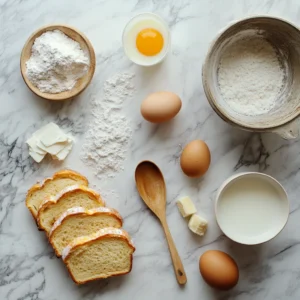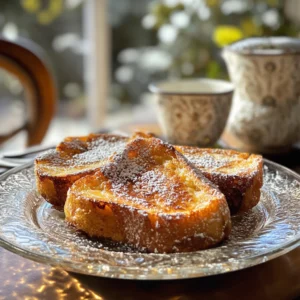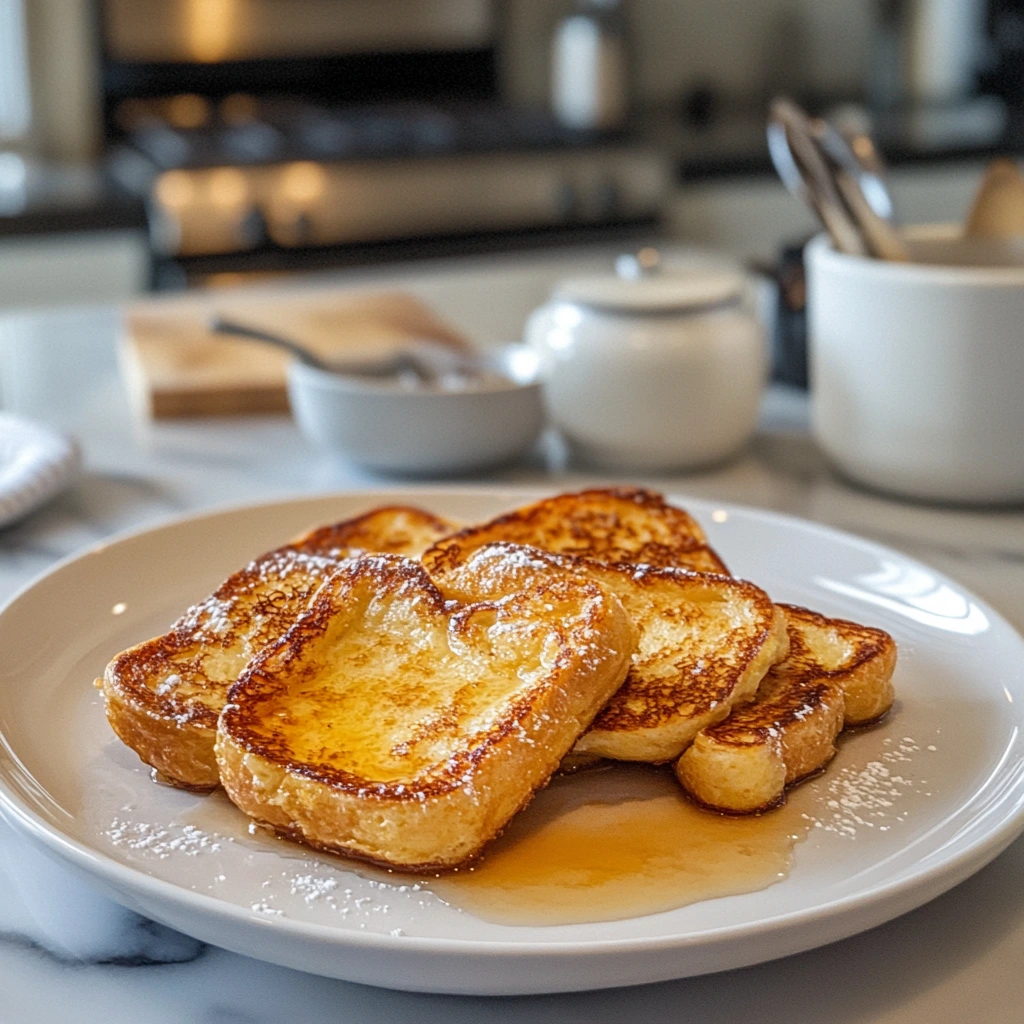Discover the art of preparing a luxurious twist on a classic breakfast favorite with our brioche french toast recipe. This comprehensive guide is designed for home cooks and brunch enthusiasts who are eager to elevate their morning routines with refined techniques, gourmet ingredients, and creative presentation.
In this article, we explore the history of French toast, discuss why brioche makes all the difference, and provide an in-depth, step-by-step guide to crafting the perfect dish.
We also include tips for variations, serving suggestions, and answers to frequently asked questions. Whether you are a seasoned cook or a beginner, this guide will help you create a memorable breakfast experience.
Introduction
French toast has long been a beloved dish across cultures and generations. When made with brioche, a rich, buttery bread known for its soft texture and subtle sweetness, the result is an extraordinary breakfast that stands apart from the ordinary. Our brioche french toast recipe not only elevates the flavor profile of traditional French toast but also provides a sophisticated texture and an enticing aroma that will impress any guest.
From its origins as a practical way to use up stale bread, French toast has evolved into a gourmet dish with endless possibilities. Today, we invite you to explore the evolution of this classic breakfast item and learn how to transform simple ingredients into a culinary masterpiece. For more information on food safety while preparing your recipes, please refer to USDA Food Safety Guidelines.
A Brief Historical Overview
French toast has a fascinating history that spans centuries. Originally conceived as a way to revitalize stale bread, the dish has roots that extend deep into European culinary traditions. Ancient Romans are known to have prepared similar recipes, and over time, the concept spread across cultures, each adapting the dish to their own tastes and available ingredients.
The transformation of French toast from a humble, economical meal into a luxurious brunch staple is closely linked to the introduction of high-quality breads, particularly brioche. With its origins in France, brioche was originally a celebratory bread, reserved for special occasions due to its rich ingredients and delicate preparation. Over time, it became accessible to a wider audience, and its inherent qualities made it an ideal candidate for the evolution of French toast into something both elegant and indulgent.
In modern times, French toast has become a canvas for culinary creativity. Chefs and home cooks alike experiment with various flavor combinations, from sweet to savory, making it a versatile dish suitable for any meal of the day. For further insights into the art of gourmet breakfast recipes, consider reading The Ultimate Guide to French Toast Recipe, which delves into variations and techniques that can transform your breakfast repertoire.
Why Brioche Makes a Difference
The choice of bread is critical in achieving the perfect French toast, and brioche stands out for several compelling reasons. Unlike standard bread, brioche boasts a tender crumb and a slightly sweet, buttery flavor that naturally enhances the dish. Its delicate structure is uniquely suited for soaking up the rich custard mixture without becoming overly soggy, ensuring that the final product maintains a desirable balance between softness on the inside and a satisfyingly crisp exterior.
Brioche’s luxurious texture and flavor profile make it the preferred choice for those who wish to create a gourmet breakfast experience at home. The inherent sweetness of the bread complements the spices and other flavorings in the custard, resulting in a harmonious blend of taste that is both comforting and sophisticated. Additionally, the visual appeal of thick, golden slices of brioche elevates the presentation, making your dish as pleasing to the eye as it is to the palate.
For those who are curious about how variations of French toast can be further enhanced with creative fillings, our article on Stuffed French Toast Recipe offers innovative ideas to transform your breakfast.
Ingredients: The Foundation of Excellence

Creating the perfect brioche french toast begins with selecting the right ingredients. Each component of the recipe plays a crucial role in the overall flavor and texture of the dish. By using high-quality ingredients, you ensure that every bite is a delight.
The core ingredients for this recipe include:
- Brioche Bread: Choose a freshly baked, thick-sliced brioche that is slightly stale. This allows it to absorb the custard without disintegrating during cooking.
- Eggs: Fresh eggs provide the structure and richness needed for a smooth custard.
- Milk or Cream: Use whole milk or even cream for a richer, more decadent custard. Alternatives such as lactose-free milk can be used for dietary restrictions.
- Sugar: A small amount of sugar adds a subtle sweetness to balance the flavors.
- Flavorings: Essential spices include vanilla extract, cinnamon, and a pinch of nutmeg. These enhance the custard and create a warm, inviting aroma.
- Butter or Oil: For cooking, a generous knob of butter or a splash of oil helps achieve a golden-brown crust.
Optional enhancements might include a splash of rum or brandy for added depth, or the incorporation of additional spices to suit your taste.
Essential Equipment and Tools
Having the right tools in your kitchen is just as important as using the best ingredients. The following equipment will ensure your brioche french toast turns out perfectly every time:
- Non-Stick Skillet or Griddle: A quality non-stick surface helps in achieving an even, golden-brown crust without sticking.
- Mixing Bowl and Whisk: These are essential for thoroughly blending the custard ingredients until a smooth mixture is achieved.
- Spatula: A good spatula is necessary for flipping the slices gently to avoid breaking them.
- Optional Tools: An electric mixer can be useful for creating a perfectly smooth custard, and a baking sheet can help keep your toast warm after cooking.
If you’re looking to further refine your culinary skills, consider reading our guide on How to Sharpen a Knife: A Comprehensive Guide, which provides practical tips for maintaining your kitchen tools.
Step-by-Step Preparation Method
Crafting the perfect brioche french toast requires careful attention to detail. Follow these steps to create a dish that is both flavorful and visually stunning.
Preparing the Custard
Begin by preparing the custard, which is the heart of the French toast. In a large mixing bowl, combine the eggs, milk (or cream), sugar, vanilla extract, cinnamon, and nutmeg. Whisk these ingredients together until the mixture is completely smooth and uniform. This step is crucial, as a well-mixed custard ensures that every slice of brioche is evenly coated with flavor.
Take your time during this process to ensure that there are no lumps, and the consistency is just right. A smooth custard will not only impart flavor evenly but will also help the brioche absorb the liquid without falling apart during cooking.
Soaking the Brioche
Once the custard is ready, it’s time to prepare the brioche. Lay out your thick-sliced brioche on a clean surface. Dip each slice into the custard, allowing it to soak for about 30 seconds on each side. The key here is to let the bread absorb the custard without becoming overly saturated. Over-soaking can lead to a mushy texture, while under-soaking might result in a lackluster flavor profile.
When dipping the brioche, ensure that every part of the slice is evenly coated. This process is what gives the French toast its unique flavor and texture—a perfectly balanced interplay between the crisp exterior and the soft, custard-infused interior.
Cooking the French Toast
With the brioche properly soaked, preheat your non-stick skillet or griddle over medium heat. Add a generous amount of butter or oil to the pan, allowing it to melt and heat until it shimmers. Carefully place the soaked slices into the skillet. Cook each side for approximately 2-3 minutes, or until a beautiful golden-brown crust forms.
It is important to monitor the heat during cooking. If the pan is too hot, the brioche may burn before the custard inside is fully cooked. Conversely, if the heat is too low, the toast may become soggy. The goal is to achieve a crispy exterior while keeping the interior soft and flavorful.
After cooking, remove the slices from the skillet and let them drain on a paper towel to remove any excess oil. If you desire an extra-crispy finish, you can place the slices in a preheated oven for a few minutes before serving.
For additional insights into mastering breakfast textures and flavors, you might also enjoy The Ultimate Pancakes Recipe: A Guide, which covers similar techniques.
Creative Variations and Enhancements

One of the most exciting aspects of the brioche french toast recipe is its versatility. This dish can be easily customized to suit your taste preferences, whether you lean towards sweet or savory flavors.
Sweet Variations
If you prefer a sweeter breakfast, consider these enhancements:
- Fruit Toppings: Fresh berries, sliced bananas, or sautéed apples add natural sweetness and a burst of color.
- Sauces: Drizzle your French toast with high-quality maple syrup, chocolate sauce, or a homemade fruit compote to amplify the flavor.
- Custard Infusions: For an extra twist, add almond extract or a splash of orange liqueur to the custard. These subtle additions can transform the dish into a gourmet treat.
Savory Twists
For those who enjoy a savory breakfast, there are plenty of creative options:
- Herb-Infused Custard: Incorporate finely chopped herbs like rosemary or thyme into the custard mixture. These herbs impart a delicate aroma and a unique flavor profile.
- Savory Accompaniments: Pair your French toast with savory sides such as crispy bacon, poached eggs, or a fresh garden salad. The contrast between the sweet, custard-soaked brioche and savory toppings creates a balanced and satisfying meal.
Presentation and Plating
The visual appeal of your brioche french toast can elevate the entire dining experience. Consider these presentation tips:
- Dust the finished slices with powdered sugar or a light sprinkle of cinnamon.
- Arrange the toast artistically on a plate, garnished with fresh mint leaves and a scattering of berries.
- For a layered effect, you can add a dollop of whipped cream on top or serve the toast with a side of homemade fruit compote.
Serving Suggestions and Pairings
A gourmet breakfast is not complete without the perfect accompaniments. When serving your brioche french toast, consider pairing it with complementary flavors and textures to create a truly indulgent meal.
Beverage Pairings
A well-chosen beverage can elevate the overall dining experience. Here are a few suggestions:
- Coffee: A freshly brewed cup of coffee, whether it’s a rich espresso or a smooth latte, pairs beautifully with the sweetness of the brioche.
- Tea: For those who prefer tea, a fragrant herbal tea or a robust black tea can provide a delightful contrast to the creamy custard.
- Brunch Cocktails: A refreshing mimosa or a light sparkling wine can add a celebratory touch to your brunch spread.
Side Dishes
Enhance your meal by adding side dishes that complement the flavors of your French toast:
- Fresh Fruit Salad: A medley of seasonal fruits not only adds color to the plate but also provides a refreshing balance to the rich custard.
- Yogurt Parfait: A light and creamy yogurt parfait with granola and honey can be a delightful addition.
- Light Salads: A simple green salad with a lemon vinaigrette can offer a crisp contrast to the softness of the toast.
For those interested in exploring more creative breakfast pairings, consider our article on The Ultimate Guide to French Toast Recipe for additional inspiration.
Frequently Asked Questions
In our experience, there are several common questions that arise when preparing brioche french toast. Here are some of the most frequently asked questions along with their answers:
What type of brioche works best for French toast?
Using freshly baked, thick-sliced brioche that has slightly lost its freshness is ideal. This ensures that the bread soaks up the custard evenly while retaining its structure during cooking.
How long should the brioche soak in the custard?
Typically, 30 seconds per side is sufficient. This timeframe allows the bread to absorb the flavors without becoming overly soggy, resulting in a perfect balance of texture.
Can I prepare the custard in advance?
Yes, you can mix the custard ahead of time; however, it is best to soak and cook the brioche just before serving to maintain its optimal texture and flavor.
What are the best toppings for brioche french toast?
Popular toppings include fresh berries, sliced bananas, powdered sugar, and a drizzle of high-quality maple syrup or fruit compote. Experiment with your favorite fruits and sauces to find your ideal combination.
How should I reheat any leftovers?
If you have any leftovers, reheat them in a preheated oven at a low temperature to help retain the crisp exterior while warming the custard inside.
For additional troubleshooting tips and expert advice on maintaining the perfect texture, please see our internal FAQ on Troubleshooting Your French Toast.
Bringing It All Together: The Final Touches

As you embark on your journey to create a gourmet breakfast, remember that the magic of brioche french toast lies in the details. From selecting high-quality ingredients to meticulously following each step of the preparation process, every element contributes to the final masterpiece on your plate.
Take a moment to appreciate the transformation: what started as a humble piece of brioche becomes a work of culinary art when bathed in a perfectly spiced custard, delicately soaked, and cooked to a golden perfection. The aroma, the flavor, and the visual appeal combine to create an unforgettable breakfast experience that can elevate any morning into a celebration.
Conclusion
In conclusion, this comprehensive guide has equipped you with all the knowledge necessary to create a truly exceptional brioche french toast that stands out from the everyday breakfast fare. By understanding the history of French toast, recognizing the unique qualities of brioche, and following our detailed preparation method, you are well on your way to crafting a dish that is both delicious and visually stunning.
We encourage you to experiment with variations—whether adding sweet fruit toppings or incorporating savory herbs—to tailor the recipe to your personal taste. Remember, the secret to great cooking is not just in following a recipe but also in putting your own creative spin on it.
Whether you are hosting a brunch for friends or simply enjoying a quiet morning at home, this brioche french toast recipe is sure to delight your senses and leave a lasting impression. Embrace the process, enjoy the flavors, and most importantly, share your culinary creations with those you love.
Bon appétit !

